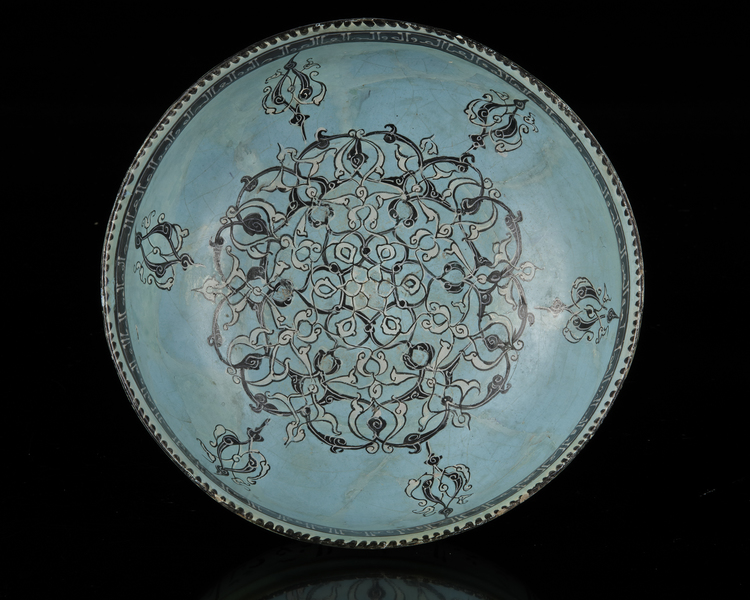* A SELJUK POTTERY BOWL, PERSIA, 13TH CENTURY
An outstanding hemispherical bowl, decorated with a black and white pattern painted under a beautiful turquoise glaze.
The interlaced motifs intertwine harmoniously with each other, so as to form a large rosette at the center of the vessel. Several other patterns (6) frame the central decoration, representing a double flower, which is also composed of black and white elements. Two friezes of Arabic calligraphic inscriptions adorn the cup, like decorative ornaments. On the inside, Kufic characters, characterized by their angular shape, can still be deciphered; on the outside, the surface is decorated with the much more rounded, cursive naskhi script. Typologically, this cup can be classified in the group of Islamic lusterwares, whose successful process involved two firing sessions: the vessel was first fired to harden the clay, and was then given a second firing to produce the lustrous shine. This technique was probably invented in Iraq, the power center of the Abbasids, between the 8th and the 9th century. Widely used by the potters of Cairo under the Fatimid dynasty (10th and 11th century), it spread to the Syrian world in the 12th century. In Persia, the production of lusterware started in the late 12th century. The city of Kashan quickly became the major center of production.
Good overall condition; several restorations, repainting and minor losses.
Height: 8.7 cm.
Diameter: 20 cm.
PROVENANCE
Swiss collection acquired 06.2009 on the French art market. Ex-collection Engel Gros.
Presence of a label that reads “Engel Gros".
BIBLIOGRAPHY
PANCAROGLU O., Perpetual Glory, Medieval Islamic Ceramics from the Harvey B. Plotnik . Collection, Chicago, 2007, pp. 105-106, nos. 63-64. Terres d’Islam, Les collections de céramiques moyen-orientale du Musée Ariana à Genève,
Geneva, 2014, nos. 50-55, pp. 70-73. WATSON O., Ceramics from the Islamic Lands, Kuwait National Museum: The Al-Sabah Collection, London, 2004, pp. 332-337.
- SPECIAL NOTICE This lot is imported from outside the EU for sale using a temporary import regime. Import VAT is payable (at 9%) on the hammer price. The 30% buyers premium is subject to 21% VAT for EU citizens. When the buyer of this is registered an EU address but wishes to export the lot or complete the import into another EU country he must contact Oriental Art Auctions after the auction.




